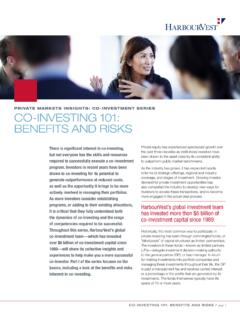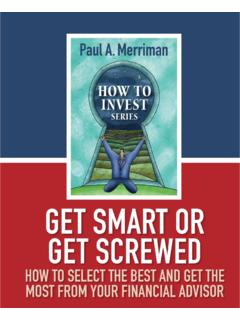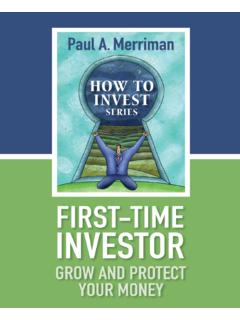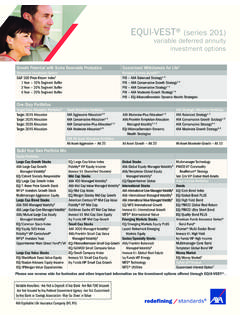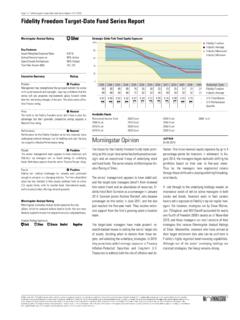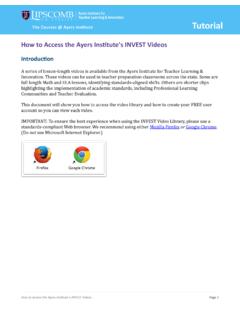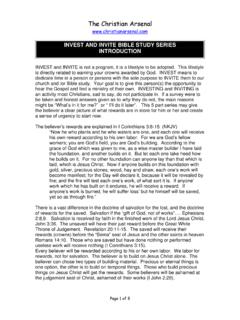Transcription of THE BASICS OF SAVING INVESTING
1 A PRODUCT OFINVESTOR EDUCATION 2020 THE BASICS OF SAVING + INVESTINGA Message to EducatorsThe BASICS of SAVING and INVESTING : Investor Education 2020 is a project of the Investor Protection Trust (IPT) and the Investor Protection Institute (IPI). This unique teaching tool provides school age and adult learners with non-commercial information that they need to know for sound financial decision-making and INVESTING throughout their lives. You can use The BASICS of SAVING and INVESTING : Investor Education 2020 as the framework for an entire course or as part of a semester or year of instruction. The guide is complete with lesson plans, worksheets, overheads/handouts and tests covering each unit. Divided into four self-contained units, BASICS focuses on the following learning objectives: Understanding the financial markets Making sound financial and investment decisions Selecting among the various SAVING and INVESTING options Recognizing and victim-proofing yourself against investment fraud Knowing how regulators help to protect investorsThe BASICS of SAVING and INVESTING : Investor Education 2020 is available for download on the IPT website at along with additional investor education booklets and videos.
2 We hope you will join the thousands of educators using this Investor Protection Trust/Investor Protection Institute teaching guide. We trust that you will find it an enriching experience in many to know more about IPT and IPI?The Investor Protection Trust is a nonprofit organization devoted to investor education. Since 1993 the Investor Protection Trust has worked with the states and at the national level to provide the independent, objective investor education needed by all Americans to make informed investment decisions. The Investor Protection Trust strives to keep all Americans on the right money track. For more information, go to Visit IPT on Facebook at and on Twitter at The Investor Protection Institute is an independent nonprofit organization that advances investor protection by conducting and supporting unbiased research and groundbreaking education programs. IPI carries out its mission through investor education, protection and research programs delivered at both the national and grassroots levels in collaboration with state securities regulators and other strategic partners.
3 IPI is dedicated to providing innovative investor-protection programs that will make a meaningful difference in the financial lives of Americans in all walks of life and at all levels of sophistication about financial matters. For more information, go to Visit IPI on Facebook at and on Twitter at Investor Protection TrustThe Investor Protection InstituteINVESTOR EDUCATION 2020 THE BASICS OF SAVING + INVESTINGA cknowledgementsCONTRIBUTIONSThe BASICS of SAVING and INVESTING : Investor Education 2020 has been made possible in your state and nationally by the involvement and support of the Investor Protection Trust ( ).Special thanks to State Securities Regulators and Investor Education Coordinators for their input and support for The BASICS of SAVING and INVESTING teaching guide. This publication benefited from a series of investor education booklets developed by the Kiplinger Washington Editors, Inc.
4 And the Investor Protection EDUCATION 2020 THE BASICS OF SAVING + INVESTINGINTRODUCTION Welcome letter A Message to Educators AcknowledgementsUNIT 1 Getting Started Defining Investor Education Why People Save and invest How to Think About Making Financial Decisions Key Concepts of SAVING and INVESTING Unit 1 Test/Answer KeyUNIT 2 Introduction to Financial Markets Understanding Risk and Return How Financial Markets Work savings , Stocks, Bonds, Mutual Funds and Other Investments Regulation of Financial Markets Unit 2 Test/Answer KeyUNIT 3 Making a Financial/Investment Plan Introduction to Financial Planning/ INVESTING Concepts Framing a Plan to Meet Individual Financial/Investment Goals Selecting Financial Professionals Unit 3 Test/Answer KeyUNIT 4 Investment Fraud Introduction to Investment Scams, Schemes and Swindles How Telemarketing Fraud Works Inside the Boiler Room Teach Individuals to Become Victim-Proof.
5 Self-Defense Tips Against Fraud How Regulators Help to Protect Investors Unit 4 Test/Answer KeyAPPENDIX Resources and Materials Organizations and Agencies Glossary of TermsINVESTOR EDUCATION 2020 THE BASICS OF SAVING + INVESTINGINVESTOR EDUCATION 2020 THE BASICS OF SAVING + INVESTINGUNIT 1 I Getting Started1 I Getting StartedTHE BASICS1 1 I 12020 UNITINVESTOR EDUCATIONUNIT 1 I Getting StartedTEACHING STANDARDS/KEY TERMS Benefits Choices Compound interest Decision-making Diversification Financial plan/Investment plan Goals Interest rate INVESTING Limited resources Market returns Needs vs.
6 Wants Opportunity costs Rainy day fund Risk savings Time value of money Trade-offs ValuesUnit Objectives:INDIVIDUALS WILL: Discuss why people save and invest . Learn how to think about financial decisions. Understand key concepts of SAVING and INVESTING (including the time value of money ).THE BASICS1 1 I 2 2020 UNITINVESTOR EDUCATIONUnit Teaching AidsLESSON 1: INVESTING in the Real World (Handout)LESSON 2: SAVING and Investment Products (Handout) Comparing SAVING and Investment Products (Worksheet)LESSON 3: Pyramid of Investment Risk (Overhead and Worksheet) Investment Risk (Quiz and Answer Key) Time Value of Money (Chart and Worksheet) Rule of 72 (Worksheet)UNIT TEST: (Test and Answer Key)For Instructors Defining Investor Education This expanded and updated teaching guide is about investor education helping young and adult learners understand how to successfully save and invest in order to achieve their future financial goals.
7 You probably have seen a number of teaching guides and student workbooks in recent years that cover important topics such as how to balance a checkbook, deal responsibly with a credit card, buy life insurance, and make other financial decisions. That is why the teaching guide you are now reading focuses on one thing and one thing only: investor education. As such, The BASICS of SAVING and INVESTING : Investor Education 2020 concentrates on such financial products as stocks, bonds, mutual funds, 401(k) retirement plans, IRAs, and other major investment tools. If you want to teach your students about other issues, such as the responsible use of credit, buying insurance, etc., please consider using this teaching guide as an investment-specific supplement to the other topics that you are Teach This Unit?Learning how to invest is valuable information from which many people can benefit. Company pensions are a thing of the past.
8 Social Security is not intended to cover all of the financial needs of retirees .. and younger Americans are those most likely to doubt it will be there for them in their time of need. In order to achieve a secure future, most Americans will need to participate in the financial markets through individual INVESTING or employer-based retirement programs or both. Too many people jeopardize their future financial security by failing to take the time to learn about INVESTING . It is important, therefore, that individuals learn how the financial markets (and the products sold in them) work. The first step in that process is the focus of this Unit: Learning how smart SAVING and investment decisions are made. You, and your students, will find that it isn t nearly as intimidating a topic as they and you! may BASICS1 1 I 32020 UNITINVESTOR EDUCATIONMany people have money but few know how to manage it.
9 Nearly half of all high school students have a part-time job. Some save their money and invest it for future needs, including funding a college education, buying a car, starting a family, or even taking the first steps toward purchasing a home. But too many young people spend everything they earn .. and more! .. on food, clothes, and entertainment. Worse, all too many students have credit cards and use them to spend money they don t have and, in some cases, can t repay. By contrast, young people who understand and practice sound financial decision-making skills early in their lives are on the road to financial success. Of course, this is also true of adults who may never have learned how to plan for who start INVESTING early can become big financial winners. Students and even some adult learners may wonder at first what a course about INVESTING has to do with them. They may think they don t have much money now and have plenty of time later to worry about SAVING and INVESTING .
10 Most would think differently if they knew that just $5 a week invested at 8 percent interest beginning at age 18 would grow to $134,000 by the time they reach 65. Teenagers have an advantage that older people don t have: time. When they understand this concept and use time in their favor, young people have a much better chance of pursuing their dreams and reaching their financial goals. For adult learners, the reality is that the only thing worse than starting a bit late .. is never starting at all. LESSON 1: Why People Save and InvestMost people start SAVING and INVESTING to meet a specific goal, such as buying a car, continuing their education, or starting a family. Among the tasks adults face as they move into the working world are the following: Preparing for a career, often by going to college or a technical/vocational school. SAVING for major purchases and expenses (such as a college education, a family and a first home).






